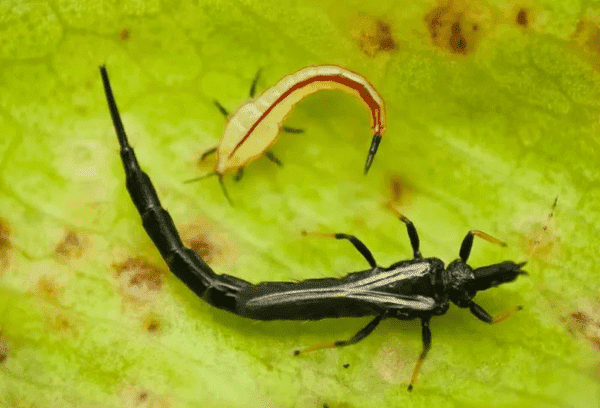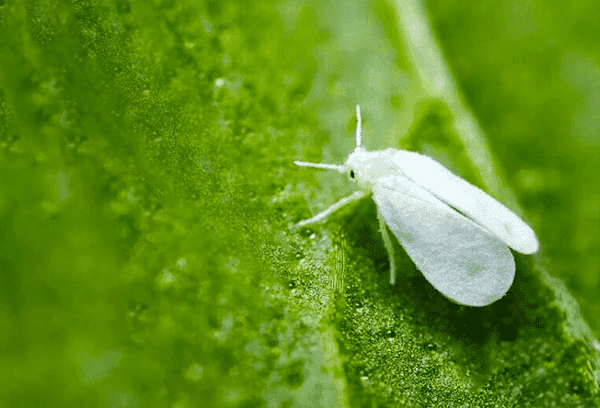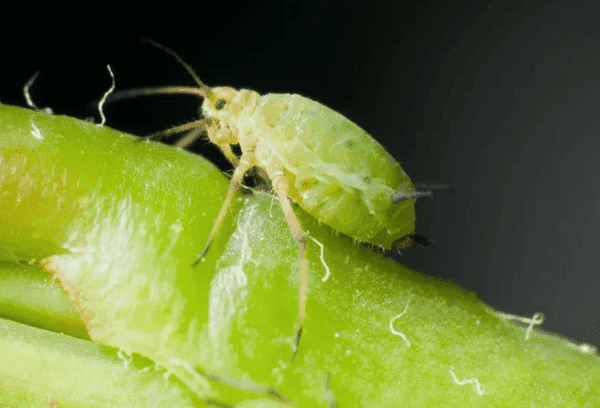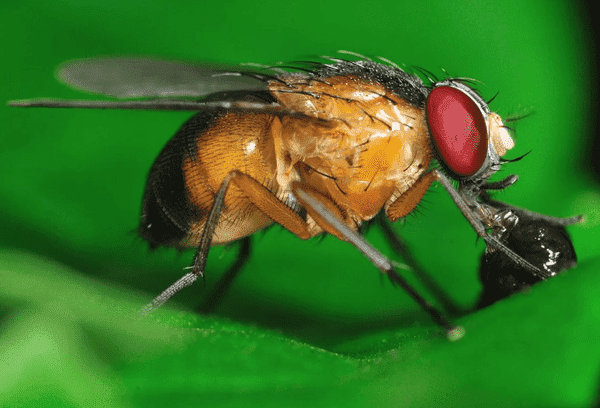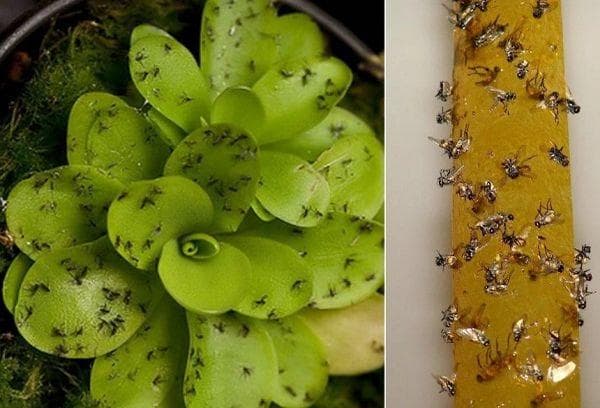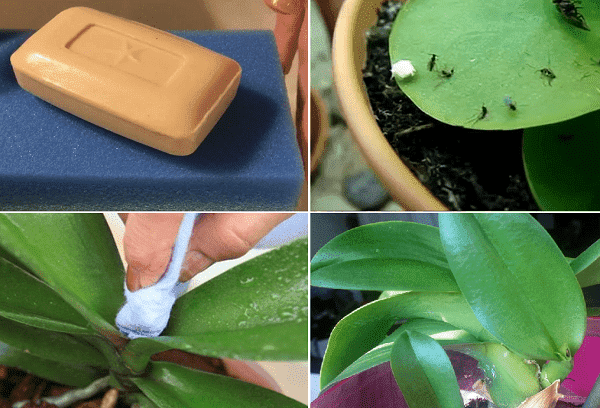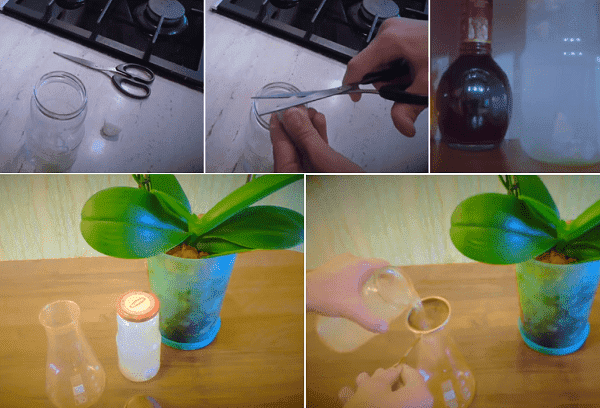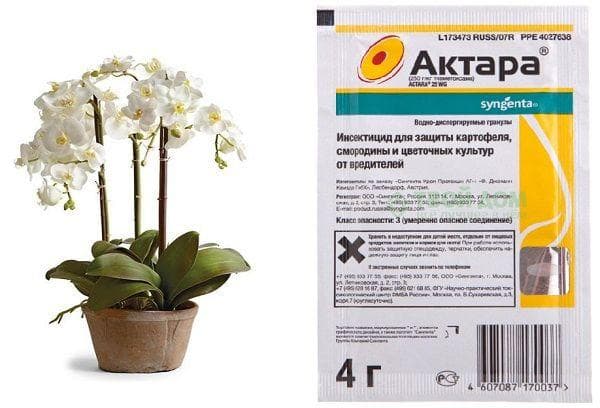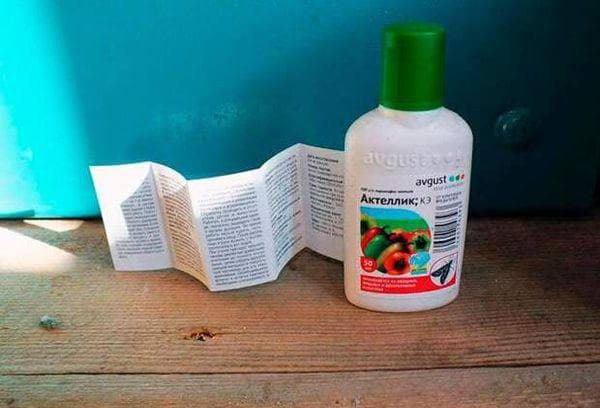There are midges in orchids: what can you do to make them disappear and not appear again?
A swarm of insects on a windowsill with flowers can frighten a plant grower. The question immediately arises, how dangerous are midges in orchids, and what to do about it? First you need to calm down and not panic. Most often, indoor plants are attacked by fungus gnats, which are not difficult to remove.
Content:
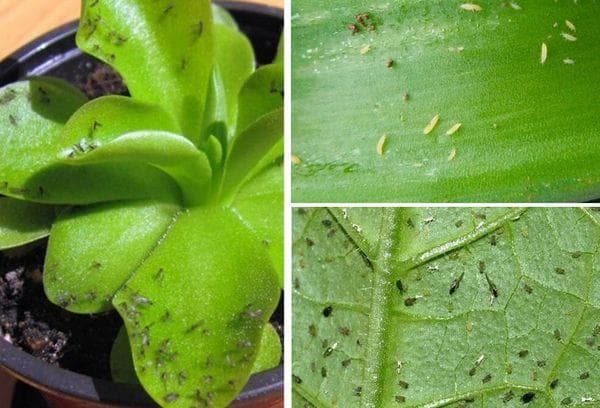
Why did midges appear in the orchid?
April is the most fertile time for midges. The heating is turned off, the apartments become humid, and residents rush to open the windows. There may be several reasons for the appearance of insects in flowers:
- Violation of the irrigation regime. A humid environment is attractive to insects. Some types of midges lay eggs in the soil. Without water they dry out and die. If the substrate in which the orchid grows does not dry out, sooner or later the “tenants” will choose it.
- Open window. There are several ways for midges to enter a house. Sometimes it’s just a window open for ventilation. Flying insect species regularly visit human homes. Once they find suitable conditions, they stay.
- New plant in the house. The number one reason for the appearance of midges in the house, especially thrips, fruit flies and whiteflies. They often live with breeders and in shops. They are regularly fought. But sometimes a couple of pests still end up on flowers for sale. In appearance, the plant may seem healthy, but 2 weeks pass, and a couple of inconspicuous midges turn into a whole swarm.
- The presence of moss, rotten bark, and earth in the substrate. Any components of the substrate that take a long time to dry out are attractive to midges and increase the risk of their appearance.
- Contaminated soil. Less often, but it still happens that midges get into the house along with the soil. Usually this is garden soil, not disinfected in any way.
What kind of midges can live in an orchid?
An orchid can harbor different types of midges. Some of them are quite harmless, others can eat the plant in a few weeks.
- Sciaridae (fungus gnat). The most common type of midge in domestic flowers. Lives in the ground and rises into the air when watered. If a black swarm flies over an orchid, then these are definitely fungus gnats. Adults look like small mosquitoes. They do not cause harm, do not bite humans and do not eat plants. Sciarid larvae that gnaw on plant roots are relatively dangerous. In transparent pots they are visible to the naked eye. Small white worms with a black head stand out against the dark background of the soil.
- Thrips. These insects can be loosely called midges. They do not fly, but rather run quickly. Males have sharp wings, females do not. A characteristic feature is a sharp tail. Thrips are dangerous for orchids. Adults eat plant leaves, transmit viral diseases and provoke fungal diseases. Their presence is indicated by small bites and egg laying in places where the leaves touch.Leaves and flowers become like parchment. Over time, the bite sites dry out and turn yellow.
- Whitefly. Famous inhabitant of greenhouses. Loves warmth, humidity, stagnant air. Whiteflies are easy to spot. Small whitish midges, similar to moths, rise into the air if you shake the plant slightly. The larvae eat the leaves, secreting honeydew. The underside of the leaf becomes sticky, and the upper side becomes covered with small tubercles. The affected plant is often attacked by sooty fungus. Whiteflies are very difficult to hatch and multiply quickly. It rarely grows in orchids; it prefers pelargoniums and fuchsias.
- Aphid. A small midge, about 1 mm in size, feeding on plant sap. Most often, its color matches the color of the leaves. Aphids can be flying or not. It's hard to notice. The appearance of an insect is indicated by deformed flowers and leaves. They begin to curl and become covered with a sticky coating. You need to look for aphids on young shoots and buds on the underside.
- Drosophila. Red-brown midges, also called fruit flies. Outwardly they are very similar to ordinary flies, only small. They appear in orchids mainly when housewives water the flowers with water after boiling eggs, vegetables, or use rotting organic matter as fertilizer. Drosophila larvae can eat orchid roots. Drosophila are low-risk and relatively easy to remove. The soil needs to be replaced.
How to remove midges with home remedies
If midges in orchids have appeared recently and have not had time to multiply significantly, you can try to destroy them with improvised means. Such methods are absolutely safe and will not harm pets or children. But you still shouldn’t count on them too much.
Home remedies are effective against adults.They have no effect on midge larvae and eggs.
Therefore, do not rush to rejoice when the insects disappear after treatment. If oviposition remains somewhere, a new midge invasion may occur in 3-7 days.
Yellow adhesive tape and saucer of water
An old folk method helps to quickly get rid of sciarids. Surprisingly, these insects fly to the yellow color. They are not very smart, so they fall into traps well.
Experienced gardeners fight fungus gnats this way:
- Hang yellow sticky tape (regular, for catching flies) near the orchid.
- Place a yellow saucer with water next to the pot. If there is no yellow saucer, you can put yellow colored paper or a piece of yellow bag on the bottom.
- Adults quickly fall into traps.
- To destroy the larvae, reduce watering. They do not hatch in a dry substrate and die after a few days.
- The adhesive tape and saucer are left for 2 weeks. If during this time no one falls into the traps, you can celebrate your victory.
Laundry soap
One of the most popular home remedies against midges in indoor flowers. Laundry soap does not harm the orchid, but it effectively kills insects. Rinsing the soap also removes larvae and eggs.
Laundry soap helps in 90% of cases. But it is not advisable to use it on a blooming or recently transplanted (young) orchid.
How to get rid of midges in an orchid using soap:
- Put on rubber gloves and move the orchid into the bathroom.
- Take a soft washcloth or cotton pad.
- Moisten laundry soap with water and lather.
- Lather all the leaves one by one.
- The orchid should stand in a thick layer of foam for 10-15 minutes.
- Rinse the flower well with a stream of warm water (at least 5 minutes!).
- Wash the orchid along with the soil to remove the larvae and eggs of midges.
- Leave the flower to drain for 6 hours, and then return it to its permanent habitat (thoroughly washed with laundry soap!)
Important! Soap should not contain bleaching additives.
Garlic water
Garlic repels midges from orchids and confuses them. The pungent odor interrupts the natural aroma of greenery and most often the insects disappear. Garlic also works well as a preventative.
You need to finely chop 4 cloves of garlic, pour the pieces into a glass jar and pour 1 liter of cold water. Garlic water should sit covered for 4 days.
After this, the liquid is filtered and the soil mixture is watered. If midges live on the leaves, garlic water is also sprayed on the above-ground parts. Garlic water is even beneficial for orchids. It strengthens the immune system and stimulates growth.
How to remove midges with store-bought preparations?
Having noticed that midges have appeared in the orchids, you need to immediately take action:
- Place a bag on top of the pot and take it out to the balcony (street) or to a separate room.
- Plants standing nearby must be quarantined for 2 weeks.
- The infected orchid is examined. If there are a lot of insects and the plant is severely damaged, it is necessary to treat it with an insecticide.
- Before this, the plant is washed with laundry or green soap.
- Severely affected leaves and roots are removed. Change the soil.
Store-bought mosquito repellents are insecticides—poisons that kill insects. They are also harmful to humans. The treatment is carried out outdoors or in a well-ventilated place, wearing gloves and a mask.
"Aktara"
This well-known remedy for the Colorado potato beetle is very often used against pests of indoor plants: thrips, whiteflies, scale insects and others."Aktara" is a powerful insecticide that kills insects in 24 hours. After treating the tissue, the plants and soil become toxic to them. The poison lasts 7-28 days.
To destroy pests, 1 ml of the product is diluted in 10 liters of settled water, and then watered and sprayed on the orchid leaves. Repeated treatment is carried out on days 7-10. An Aktary ampoule (1 ml) costs approximately 60 rubles.
Advice. In order not to burn the roots and leaves of the orchid, the Aktara solution is used after showering the plant (on wet leaves and soil).
"Aktellik"
A very effective chemical. Effective on all types of midges in orchids. But at the same time it can cause severe poisoning. When processing, you need to use a respirator. An Actellika 2 ml ampoule costs 35-80 rubles. The concentrate is diluted in 2 liters of water, sprayed on the orchid leaves and watered the soil. Repeated treatment is carried out after 7-10 days.
"Fitoverm"
One of the most affordable insecticides for indoor flowers. A 4 ml ampoule costs about 15 rubles. The main active ingredient is Aversectin S. The drug causes paralysis of the digestive system of midges. The insects stop feeding and die after 3-6 days. It is classified as a mild agent. “Fitoverm” does not harm indoor flowers, but it may not cope with tenacious parasites. It is used at least 3 times with an interval of 5-7 days.
2 ml of the drug is diluted in 200-250 ml of water and watered well. If the pest lives on the leaves, “Fitoverm” is sprayed on the aboveground part.
Important. The orchid should not be watered for at least 3 days after treatment with an insecticide and fed for another 2 weeks.
Prevention methods
Even if midges in orchids are relatively harmless, finding them, to put it mildly, is unpleasant.Instead of enjoying the charming sight of flowers, you have to spend time, effort and money on a tedious struggle. Insects will not infest houseplants if you follow 3 simple rules:
- Isolate the new plant for 2 weeks.
- Follow watering standards.
- Install a mosquito net on the window.
This is the basis of the basics, which an experienced gardener will never violate. Additionally, the following measures may be taken:
- Preventive treatment with Fitoverm 1-2 times a month. If plants have been repeatedly attacked by midges, you can use this relatively “light” drug for prevention. You need to dilute a 2 ml ampoule in 400 ml of water. Water the orchid at the root and spray the leaves. The drug remains active for 2 weeks.
- Hanging up sticky tape.
- Using cinnamon. Natural cinnamon needs to be ground and sprinkled on top of the soil (literally a pinch). It is important not to get on the roots. The smell of cinnamon repels midges.
Questions and answers
How to easily detect pests on orchids?
There is a simple test. You need to cut off a slice of a juicy apple and put it in a flower pot. Check in half an hour. If there are midges, they will happily eat the “gift”.
Will a blooming orchid drop its flowers if you start fighting midges?
Probably yes. But the reason for this will not be the chemical or home remedy, but the fact of the pest itself. A weakened plant will spend energy on maintaining life rather than flowering. You also need to take into account that the orchid does not like drops of moisture getting on the flowers. Even ordinary water can trigger the shedding of flowers. If midges live only in the soil, it is better not to touch the flower stalks.
Orchid owners need to be observant. Small midges are not always noticeable.Many people do not suspect anything until a whole colony starts in the pot. At this stage, it is usually too late to use home remedies. If the damage is serious, you cannot do without chemicals. We advise you to inspect the leaves, flowers, and soil in the flower pot once a week, as well as carry out preventive maintenance. Take care of the orchid, and it will thank you with lush flowers!

